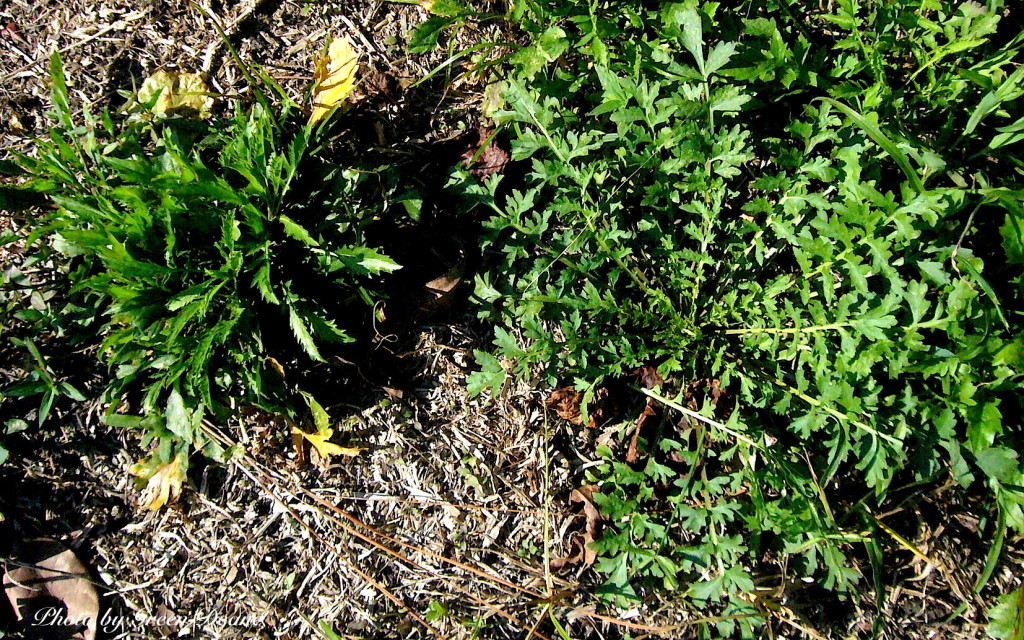
The challenge to identifying Poor Man’s Pepper Grass is it can have a wide variety of looks depending on the growth stage. Both of the main plants in this picture are Poor Man’s Pepper Grass. Photo by Green Deane
While it’s only January we’ve been seeing early vines of the Creeping Cucumber on both coasts, from Tampa to Melbourne. It’s too early to see any blossoms or fruit but in several locations protected vines that missed any frost were up to a yard long. Once they start to fruit they will continue until the short days of winter or a cold spell. Locally the last average frost date is Valentine’s Day and the last on record late April. Botanically Melothria pendula they are slightly tart jelly-bean size cukes. They’re a great trail-side nibble and good in salads. Also called the Guadeloupe Cucumber they, unfortunately, do not pickle well. To read more about them go here.
An often overlooked wild edible is Bulrush. This tall sedge gets second billing to the another common watery inhabitant, cattails. While there are several species of Bulrush locally the two one sees most often are Scirpus californicus and S. validus. Used like cattails, the easiest way to tell them apart is to look at the seed tufts location and color of the seeds which introduces an important point: The experts tell us there are no toxic sedge seeds thus if you have a sedge you have a source of edible seeds. On these species the seeds are small but are easy to harvest (if you have a boat or a canoe.) To read more about Bulrushes and to identify sedges in general go here.
In nearly every class and daily on line I am asked if I can identify a plant if a picture is sent to me. I say I will try and also suggest the sender join the Green Deane Forum. There’s a UFO page there, Unidentified Flowering Objects. On the forum we chat about foraging — and other topics — every day along with techniques to harvest and use the bounty you have found. And it’s not just about Florida or the southeast. There are members from all around North America and the world. The link to join is on this page just to the right of this article. You do have to pick a screen name and the forum let members private message each other. There are only three rules: Keep it civil, keep it clean, and don’t mention Wikipedia (which Green Deane has a significant dislike for.) Recent topics include Mystery Tree, Gnarly Mushroom, Brain Tan, Vegetarian Nightmare, Linguist Overdrive, From the Frightening Mailbag, and Young Sow Thistle.
We’re a little less than a month away from the Florida Earthskills gathering in Hawthorn Florida, Feb 5-8. It’s an opportunity to learn, share and experience sustainable living skills. I have taught there for the last two years and there are virtually dozens of classes to sign up. Personally I am hoping to take a few mushroom classes. Other classes include wild medicine, wild foods, didgeridoo making and playing, buckskin sewing, fire making, yoga, insect study, cabbage palm basketry, bow making, bird songs, atlati throwing, permaculture, mushrooms and a whole lot more, several somethings for everyone. To learn more about this Florida Earthskills gathering and sign up go here.
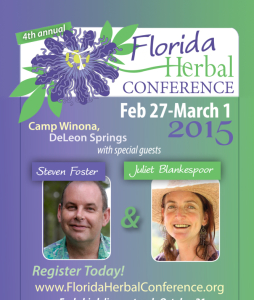 Later in February is the Florida Herbal Conference, Feb 27 to March 1st, organized by herbalist Emily Ruff. I’ve taught edible plants there for the last three years and will be there again this year. In fact I plan to spend a lot of time there. It’s a must for all southern herbalists and well as those northern ones who want to escape the cold and study their craft in the dead of winter. It always has interesting speakers and great classes. While there is some cross over between Earthskills and Herbalism the conferences are sufficiently different to justify attending both. For more information and to register go here.
Later in February is the Florida Herbal Conference, Feb 27 to March 1st, organized by herbalist Emily Ruff. I’ve taught edible plants there for the last three years and will be there again this year. In fact I plan to spend a lot of time there. It’s a must for all southern herbalists and well as those northern ones who want to escape the cold and study their craft in the dead of winter. It always has interesting speakers and great classes. While there is some cross over between Earthskills and Herbalism the conferences are sufficiently different to justify attending both. For more information and to register go here.
Foraging Classes: Saturday, January 17th, Mead Garden: 1500 S. Denning Dr., Winter Park, FL 32789. 9 a.m.; Sunday, January 18th, Spruce Creek Park, 6250 Ridgewood Ave. Port Orange, 32127, 9 a.m. Saturday, January 24th, Red Bug Slough Preserve, 5200 Beneva Road, Sarasota, FL, 34233, 9 a.m.; Sunday, January 25th, Bayshore Live Oak Park, 23000 Bayshore Rd., Port Charlotte, FL 33980, 9 a.m., meet at the parking lot at the intersection of Bayshore Road and Ganyard Street. For more information or to sign up for a class go here.
One of the odd things you can do in Florida is see plants that don’t exist. They are species the state has not collected samples of for herbarium purposes thus they don’t officially exist. One of the non-existent plants you might be seeing this time of year is Wild Pineapple, Bromelia pinguin. I discovered it Christmas Day some six years ago and look forward to its brilliant blossoming and yellow fruit. I have since found it in several location although it is officially not anywhere. And be forewarned: Should you find this plant that does not exist it is is well-armed with spines that curve in both directions so it gets you coming and going. Also it’s edibility varies person to person so caution is advised as well. To read more about the Wild Pineapple go here.
Veterinarians have issued a warning about a plant that is making horses sick locally, Creeping Indigo, Indigofera spicata. Cold weather causes this pea relative to blossom pink, making it a little easier to see. Unfortunately it is a plant favored by horses with at least one dying and others sickened. (This highlights that relying on instinctual means to avoid toxic plants is not too reliable for animals or man.) As with many toxic and invasive species Creeping Indigo was intentionally brought to Florida in 1925. The University of Florida imported it from Sri Lanka (then Ceylon) for agricultural experiments. When it killed one of two rabbits the testing stopped but the weed stayed (the second rabbit recovered after the Creeping Indigo was removed from its diet.) Within eight years Creeping Indigo was raising concerns about poisoning farm animals.
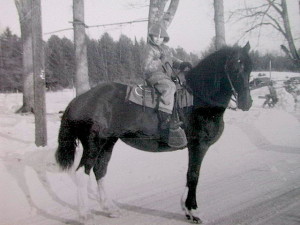
That’s Green Deane as a sprout on “Ginger.” Home included five horses, rabbits, chickens, ducks, a multitude of dogs and cats and an occasional pet squirrel.
Besides horses, it is also toxic to cattle, sheep, goats, guinea pigs, rabbits, and birds. Pigs won’t eat it which calls into question reports that it does not bother pigs. Someone might be assuming that since pigs aren’t being reported sick from eating Creeping Indigo they aren’t bothered by it whereas it could equally be that because pigs avoid it there are no reports porcine poisoning. The prime toxin in Indigofera spicata is indospicine which “inhibits the incorporation of arginine and other amino acids in liver cells result in liver insufficiency.”
For those in my Sunday class in West Palm Beach on January 11th the unknown powder puffy shrub we saw is probably a Calliandra haematocephala, a native of Malaysia. It’s a small tree that was in the pea family but has been moved to the Mimosa group. I had never seen it blossom before and as far as I can tell, is not edible in any way. It’s just pretty, which has its own value. The name is slightly interesting in that it is all living Greek mangled by Dead Latin. Calliandra is a combination of Kallos (beautiful) and Andros (man) but is to mean — when poetically translated — “pretty stamen” (the male part of the flower which creates the powder puff.) Haematocephala means “blood head” or in this case “red head.” Thus pretty stamen red head. You could even stretch it to “pretty redheaded man.”
Lastly, a new WHAT DO YOU SEE? #16. There are at least three different edible species in the photo. Can you name them?
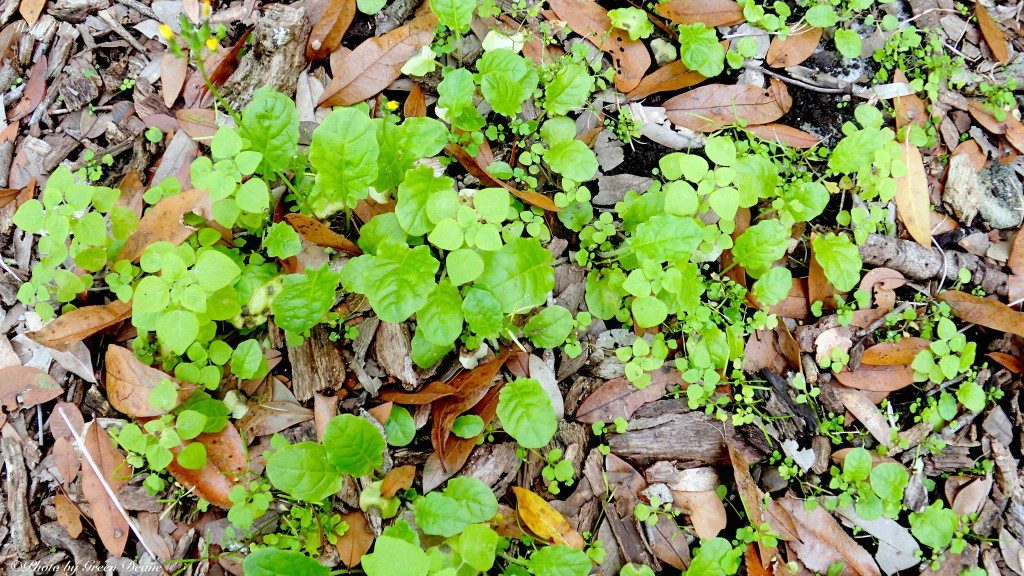
If you would like to donate to Eat The Weeds please click here

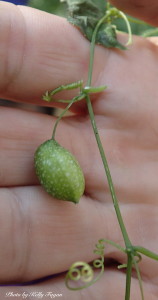
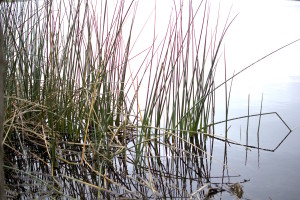

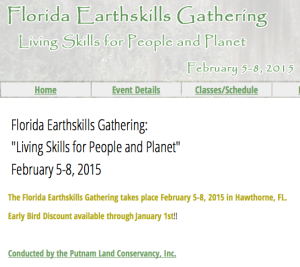
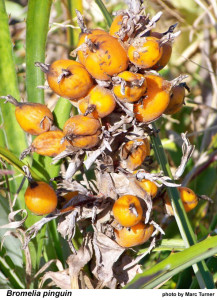
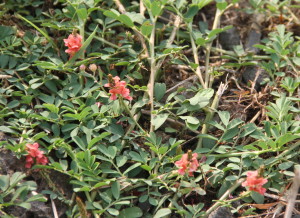
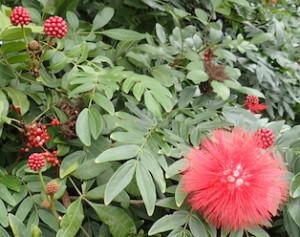

Hi Greene. I think the Earth Skills gathering in NC is sometime in early March (at least it was last year). I really want to go, but really have a problem using up my vacation for that, and not with the family. I don’t guess by any chance you would be teaching at that one would you? If so, I may be more incline to attend. I could attend a few days late in the week and weekend, that way I wouldn’t use up all my vacation. One week of vacation really isn’t enough, dag blame it!!!
Not sure if you remember, but I said that Santa brought me a juicer. Well, Santa did a little research and discovered that a real juicer gets the juice from a given plant, leaving the pulp behind, which holds a lot of nutrients. So she, I mean Santa got me a fancy blender/food processor. Now, I make me a drink based on apples, then stinging nettle, and some clover when I can find some. Now, being a guy that don’t really like a lot of veggies (much less raw), now I can juice ’em up and gulp ’em down. The whole point being, now I can reap the benefits of raw veggies, fruit, and wild edibles, and no longer have to worry so much about what it taste like. Plus, I’m not killing all my nutrients cooking the food to death. I now grow my own nettles, and planning my garden this year, with a fancy companion garden, full of wild and not so wild edibles. All the plants work together to help each other, no chemicals are used. This year I plan on more stinging nettles, milk thistle, more ground cherries, and of course tomato, sweet peppers, hot peppers too, wild alpine strawberries, and whatever more wild edibles I decide to grow.
Then, of course, growing wild edibles, I’ll have plenty of seeds, and plan on spreading them around my wooded areas to help get them back into existence. This will of course help me and the wild life, and the wild life will help them spread more. The plan looks good on paper, just hope it works as good as I hope.
I don’t think I’ve ever asked you before, but what is your thoughts on growing your own wild edibles?
Thanks for writing. I have no problem growing wild edibles (though that means at least one person within earshot will present an invasive species lecture.) I have spread many a native seed around the neighborhood to encourage edible weeds. As for Earthskills in North Carolina, I’d love to teach there but have not been invited not have I pushed the issue. Enjoy your blender.
I was thinking I see sow thistle, pellitory and wood sorrel.
One out of three, not bad.
pellitory, crepis japonica (false hawksbeard), tropical chickweed
If there is tropical chickweed (Drymaria cordata) in the picture it is eluding me. But you do have at least two of the three I see. There is at least one more edible. (We discuss this on the Green Deane Forum.)
One of our staple crops specially in western Sudan is locally called “Dukhun”. It is Pearl millet, scientifically called Pennisetum americanum ( or P. glaucum ). I wonder if you can see any relationship of this plant with Cattails as some times they call it Cattail millet and/or Bulrush millet. Another point, I’ve a weed with aromatic leaves which are intensively aromatic when dry. That is why I transferred it from my Cyprus grass lawn and transplanted separately on purpose to obtain seeds for a new generation. Fortunately it is nowadays blossoming with flowers suggestive it may be ”Spotted Knapweed (Centaurea maculosa).” However, if that is so, I may be unlucky not to harvest seeds, as it is reported that male and female flowers from two plants are required to develop the fruit. Moreover, I’m not sure if at this time of the year I may expect Spotted knapweed to blossom – a relatively very cold winter we have this year.
I think the picture has pellitory, false hawksbeard & dollarweed.
Two out of three, Pellitory and False Hawksbeard. But there is a third species, and a lot of it. (We also discuss this on the Green Deane Forum.)
pellitory, crepis japonica, and watercress!!! and the credit goes to you on pellitory, because i’ve never even seen it in person, just learned it on your website.
Watercress is close — same family. Watercress grows in water if it can.
oh bittercress!!!! I’ve been seeing it in yards and calling it watercress this whole time. I love the mustard family. One of the only families you don’t have to worry about getting it right. As long as you know it’s a mustard, your good to go. what other families are like that? mints, mallows maybe?
That’s right, Bittercress. If a plant looks like a mint and smells like a mint it is a mint. If it looks like and onion and smells like an onion it is edible, if it looks like a garlic and smells like a garlic, it’s edible.
Thank you once again. Enjoying your newsletters and always learning.